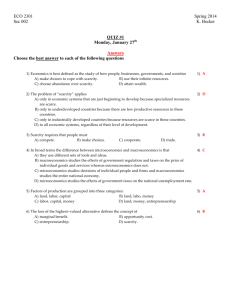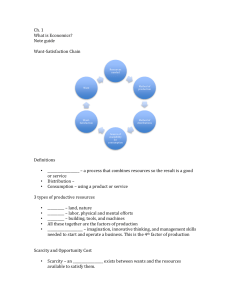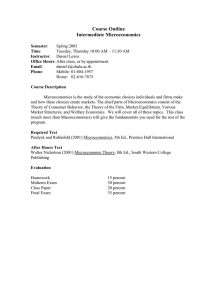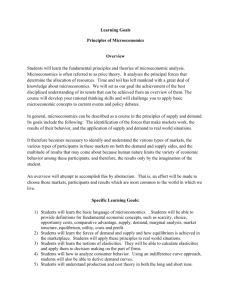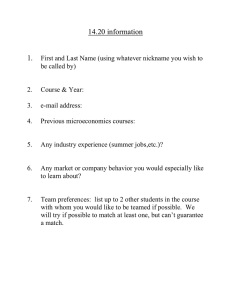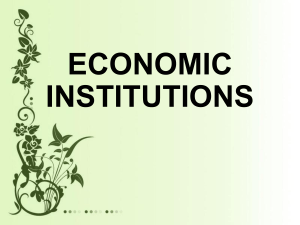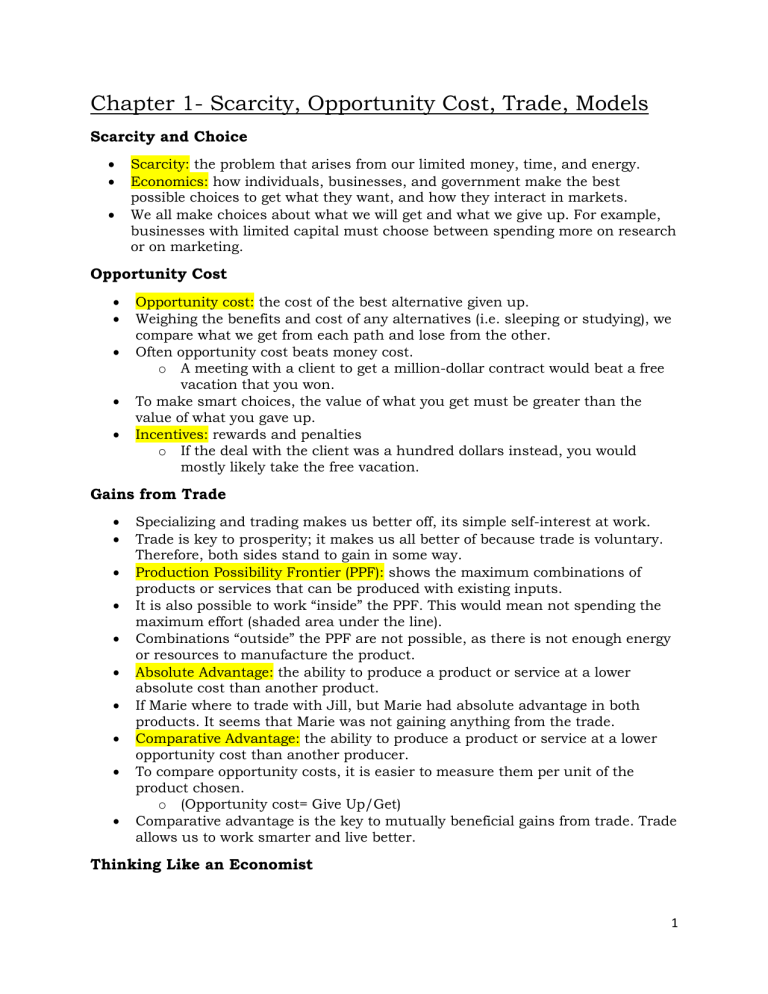
Chapter 1- Scarcity, Opportunity Cost, Trade, Models Scarcity and Choice Scarcity: the problem that arises from our limited money, time, and energy. Economics: how individuals, businesses, and government make the best possible choices to get what they want, and how they interact in markets. We all make choices about what we will get and what we give up. For example, businesses with limited capital must choose between spending more on research or on marketing. Opportunity Cost Opportunity cost: the cost of the best alternative given up. Weighing the benefits and cost of any alternatives (i.e. sleeping or studying), we compare what we get from each path and lose from the other. Often opportunity cost beats money cost. o A meeting with a client to get a million-dollar contract would beat a free vacation that you won. To make smart choices, the value of what you get must be greater than the value of what you gave up. Incentives: rewards and penalties o If the deal with the client was a hundred dollars instead, you would mostly likely take the free vacation. Gains from Trade Specializing and trading makes us better off, its simple self-interest at work. Trade is key to prosperity; it makes us all better of because trade is voluntary. Therefore, both sides stand to gain in some way. Production Possibility Frontier (PPF): shows the maximum combinations of products or services that can be produced with existing inputs. It is also possible to work “inside” the PPF. This would mean not spending the maximum effort (shaded area under the line). Combinations “outside” the PPF are not possible, as there is not enough energy or resources to manufacture the product. Absolute Advantage: the ability to produce a product or service at a lower absolute cost than another product. If Marie where to trade with Jill, but Marie had absolute advantage in both products. It seems that Marie was not gaining anything from the trade. Comparative Advantage: the ability to produce a product or service at a lower opportunity cost than another producer. To compare opportunity costs, it is easier to measure them per unit of the product chosen. o (Opportunity cost= Give Up/Get) Comparative advantage is the key to mutually beneficial gains from trade. Trade allows us to work smarter and live better. Thinking Like an Economist 1 Learning to think like an economist allows the key “roads” to stand out in making smart decisions. This kind of mentality makes understating the world around you and making tough decisions easier. Model: a simplified representation of the real world, focusing attention on what’s important for understanding. Inputs: the productive resources- labour, naturals resources, capital equipment, and entrepreneurial ability- used to produce products and services. Households and businesses interact in two sets of markets- input markets (where businesses buy the inputs, they need to produce products and services), and output markets (where businesses sell their products and services). Governments (in the middle) set the rules of the game and can choose to interact, or not, in almost any aspect of the economy. Economic models simplify the information, by leaving out unnecessary information. This can affect our decisions. We assume that things are “unchanged”, to remove the influence of the factors that are left out. Positive Statements: about what is; can be evaluated as true or false by checking the facts. Normative Statements: about what you believe you should be; involve value judgements. Negative Externalities: costs that affect others external to a choice or trade. Positive Externalities: benefits that affect others external to a choice or trade. Models for Microeconomics and Macroeconomics Microeconomics: analyzes choices that individuals in households, individual businesses, and governments make, and how those choices interact in markets. Microeconomic choices for individuals include whether to go to college or to get a job, whether to be self-sufficient or to specialize and trade. Microeconomic choices for businesses include what product or service to produce, how much to spend on research and development of new products, or which technology to use. Microeconomics choices for governments focus on individual industries. For example, should the government step in and regulate the wireless phone industry, or let competition determine the winners and losers. Macroeconomics: analyzes performance of the whole Canadian economy and global economy, the combined outcomes of all individual microeconomics choices. Focuses on the overall outcomes of market interactions, including Canadian unemployment, inflation rates, government deficits and surpluses, interest rates set by the Bank of Canada, the value of the Canadian dollar, and international trade. Also examines the policy choices governments make that affect the whole economy. Three Keys to Smart Choices Key 1: Opportunity Costs Rule 2 When you weigh benefits against costs, additional benefits must be greater than additional costs. Key 2: Look Forward Only to Additional Benefits and Opportunity Costs o When standing at a fork in the road, do not look back, only look forward. Your previous decisions, or the money you spent cannot be undone. o Marginal Benefits: additional benefits from the next choice. o Marginal Opportunity Costs: additional opportunity costs from the next choice. Key 3: Implicit Costs and Externalities Count, Too o Implicit Costs: opportunity costs of investing your own money and time. o Smart choices must include implicit costs. o 3
